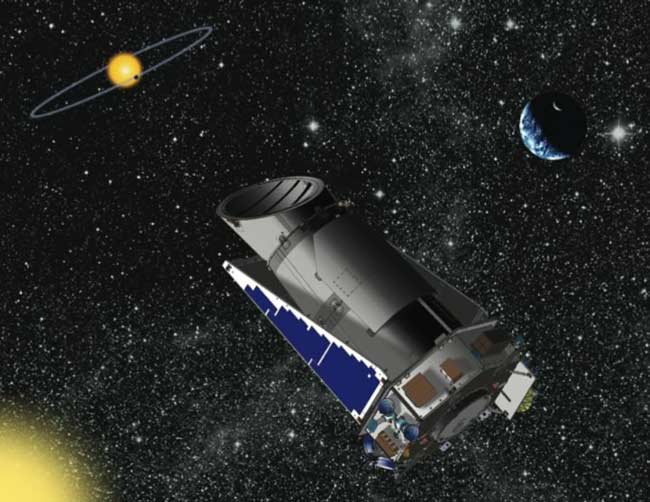Sifting for Planets With Kepler's Fine Comb

Here?s the challenge.? Take a bare 100 watt light bulb andswitch it on.? Now step back about 300 miles. Once you?re in position, arrangefor a friend to slowly pass a pinhead 30 feet in front of the bulb without noticeor warning. Your job?? Detect the decrease in light when the pinhead getsbetween you and the bulb.
I suspect that?s not something you do every day.? But NASA?sKeplertelescope will be doing it every half-hour for the next three years andmore.
Actually, not quite. Kepler will be measuring the brightnessof more than 100,000 "light bulbs."?
This new NASA space-borne instrument, which is nowcompleting its shakedowncruise, is engaged in the ultimate staring contest.? Kepler willcontinuously monitor the luminosity of 145,000 stars in the region of constellationsCygnus and Lyra, looking for dimming of as little as 0.006 percent of a star?sbrightness. Unlike other schemes for finding planets around distant stars (so-called"exoplanets"), Kepler can unearth Earths. That is, it can detectworlds hundreds of light years away that are comparable in both size andorbital position to our home planet. Cousins of the Earth ? and obviouscandidates for life.
Kepler is perched a ten million miles into space, far beyondour world?s troublesome, restless atmosphere. In truth, it?s a 100megapixel camera, taking a picture (and pretty much the samepicture!) every 30 minutes. During each month of this maniacally repetitivesurveillance, Kepler?s most recent photo collection is sent back to terrafirma.
But not all of it. Think about it: 100 million pixels everyhalf-hour for a month?? With about a byte per pixel (usually only brightnessdifferences are recorded), that?s more than a hundred gigabytes of data ? agush of results that would be painful to transmit from orbit.? What to do?
Dealing with that question is part of Jon Jenkins' jobdescription. Jenkins, a SETI Institute scientist who leads the Kepler SignalProcessing/Detection Algorithm team, reduces the data bandwidth by takingadvantage of the fact that Kepler?s photos are mostly of empty space,punctuated by stars.? The stellar targets, even when slightly splattered byoptical imperfections or telescope drift, brighten fewer than 5 percent of the telescope?spixels. It would be silly to send blank sky (including stars too faint tomeasure or background galaxies) back to the lab, over and over.
Breaking space news, the latest updates on rocket launches, skywatching events and more!
?It?s like condensing a high-school yearbook,? Jenkins says.?I?m only interested in my friends, so I can clip out their faces and leavemost of the pages behind. Saves space.?
To account for slightly smeared star images, optical changesin the telescope or drift caused by pointing error, an average of 32 pixels areallocated to each star ? a patch of the CCD detector called a "stamp."?These are the yearbook faces that are returned to Earth.
The data follow atortuous path after being telemetered from Kepler to one of NASA's DeepSpace Network antennas.? They're first routed to the Jet Propulsion Lab, andthen sent on to Kepler?s Mission Operations Center in Boulder, Colorado. Withprocessing taking place at every step along this yellow brick road, theinformation is forwarded to the Space Telescope Science Institute (think"Hubble") in Baltimore, where it?s re-organized into an easilyreadable format. It eventually lands in the offices of Jon and the rest of theKepler team at NASA?s Ames Research Center in Mountain View, California.
That?s a long trek, but fortunately the journey is highlyautomated. At Ames, 88 processors pipeline-process the data ? combing through itin a search for planets.? Light curves ? the astronomers? term for plots ofbrightness versus time ? are generated for all 145,000 stars. Those that seemto occasionally dim ? the flecks of gold in the mountains of dross ? are flaggedfor the attention of the scientists.? Each month?s data will typically have afew hundred ?hits.?
Not all hits will score, of course. There are always falsepositives requiring further scrutiny. For example, micrometeorites occasionallyslam into Kepler?s sunshade, kicking off dust that crosses the field, catchessome sunlight, and shows up in the data as a star whose brightness has suddenlychanged. Other candidates for mis-identification include so-called eclipsingbinaries ? double stars that happen to periodically get in front of oneanother.
Bottom line: Not every change in brightness is caused by aplanet. So the Kepler team is eager to get its first results analyzed thissummer while telescopes on Earth can verify at least some of its discoveries(the constellations Cygnus and Lyra are in the nighttime sky now). This ?realitycheck? will give everyone confidence that ? if Kepler turns up smaller,Earth-like planets ? the results will be credible.
Finding those terrestrial worlds will take time ? a fewyears, at least.? But that fact differentiates this mission from mostastronomical exploration. For many forays into the unknown the excitement occurswith the first few discoveries ? the first pulsars, the first quasars, thefirst black holes. After that, it?s merely a matter of adding to thecollection.
But for Kepler, the excitement waxes, rather than wanes. Inits first month or two, Kepler will uncover large numbers of ?hot Jupiters? ? bulkyplanets in tight orbits. But we know about those.? Eventually, however, thesmall fry will surface, the rocky worlds that might be the abodes ofextraterrestrial life.
"The excitement is in that glimmer of hope," saysJenkins. "The capability to find plenty of Earths ? if they?re there forus to find."
"It?s like snorkeling over a coral reef," he says."In the past, we did this with only our naked eyes. The view was blurred.Now we have goggles. I think we?re going to see wondrous things."
- Video - Planet-Hunting Kepler Takes Flight
- Video - NASA's Kepler: Hunting Alien Earths
- The Most Intriguing Extrasolar Planets

Seth Shostak is an astronomer at the SETI (Search for Extraterrestrial Intelligence) Institute in Mountain View, California, who places a high priority on communicating science to the public. In addition to his many academic papers, Seth has published hundreds of popular science articles, and not just for Space.com; he makes regular contributions to NBC News MACH, for example. Seth has also co-authored a college textbook on astrobiology and written three popular science books on SETI, including "Confessions of an Alien Hunter" (National Geographic, 2009). In addition, Seth ahosts the SETI Institute's weekly radio show, "Big Picture Science."
